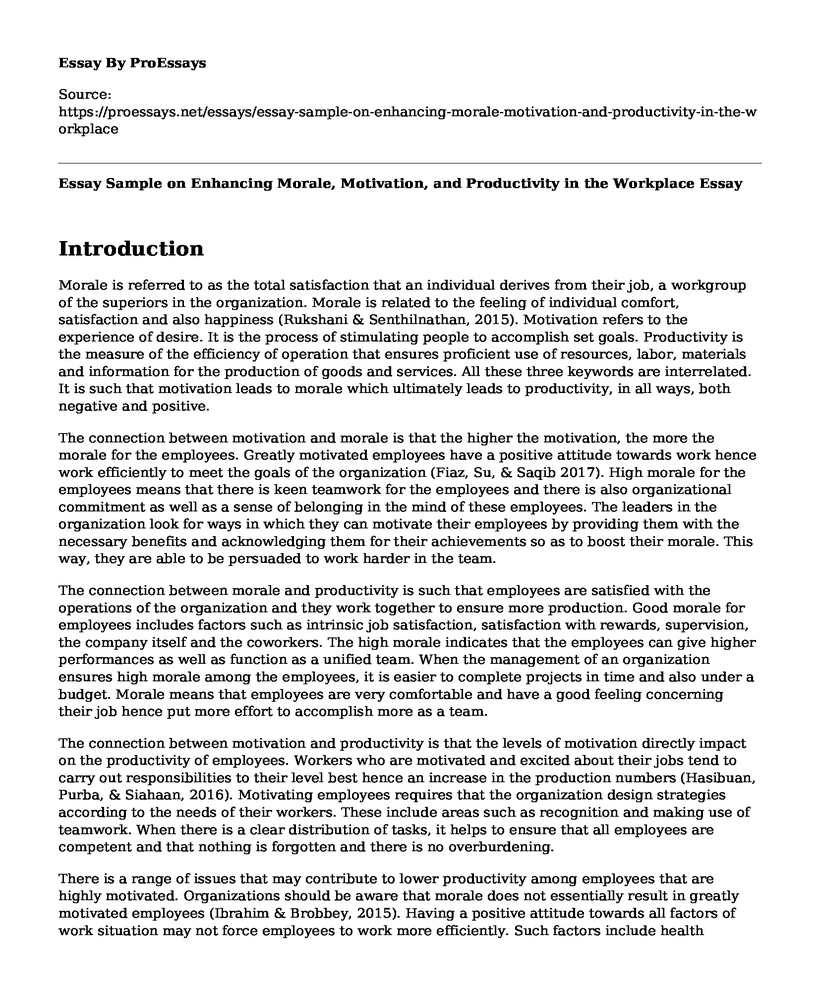Introduction
Morale is referred to as the total satisfaction that an individual derives from their job, a workgroup of the superiors in the organization. Morale is related to the feeling of individual comfort, satisfaction and also happiness (Rukshani & Senthilnathan, 2015). Motivation refers to the experience of desire. It is the process of stimulating people to accomplish set goals. Productivity is the measure of the efficiency of operation that ensures proficient use of resources, labor, materials and information for the production of goods and services. All these three keywords are interrelated. It is such that motivation leads to morale which ultimately leads to productivity, in all ways, both negative and positive.
The connection between motivation and morale is that the higher the motivation, the more the morale for the employees. Greatly motivated employees have a positive attitude towards work hence work efficiently to meet the goals of the organization (Fiaz, Su, & Saqib 2017). High morale for the employees means that there is keen teamwork for the employees and there is also organizational commitment as well as a sense of belonging in the mind of these employees. The leaders in the organization look for ways in which they can motivate their employees by providing them with the necessary benefits and acknowledging them for their achievements so as to boost their morale. This way, they are able to be persuaded to work harder in the team.
The connection between morale and productivity is such that employees are satisfied with the operations of the organization and they work together to ensure more production. Good morale for employees includes factors such as intrinsic job satisfaction, satisfaction with rewards, supervision, the company itself and the coworkers. The high morale indicates that the employees can give higher performances as well as function as a unified team. When the management of an organization ensures high morale among the employees, it is easier to complete projects in time and also under a budget. Morale means that employees are very comfortable and have a good feeling concerning their job hence put more effort to accomplish more as a team.
The connection between motivation and productivity is that the levels of motivation directly impact on the productivity of employees. Workers who are motivated and excited about their jobs tend to carry out responsibilities to their level best hence an increase in the production numbers (Hasibuan, Purba, & Siahaan, 2016). Motivating employees requires that the organization design strategies according to the needs of their workers. These include areas such as recognition and making use of teamwork. When there is a clear distribution of tasks, it helps to ensure that all employees are competent and that nothing is forgotten and there is no overburdening.
There is a range of issues that may contribute to lower productivity among employees that are highly motivated. Organizations should be aware that morale does not essentially result in greatly motivated employees (Ibrahim & Brobbey, 2015). Having a positive attitude towards all factors of work situation may not force employees to work more efficiently. Such factors include health concerns which may naturally be a big drain on the ability of the employee to be productive despite their morale. Generally, morale, motivation and productivity are interrelated such that one leads to the other. Organizations have to ensure that they have motivating factors to enhance the morale of employees and the results will be higher performance.
References
Fiaz, M., Su, Q., & Saqib, A. (2017). Leadership styles and employees' motivation: Perspective from an emerging economy. The Journal of Developing Areas, 51(4), 143-156. Retrieved from https://www.researchgate.net/profile/Amir_Ikram/publication/317884652_Leadership_styles_and_employees%27_motivation_Perspective_from_an_emerging_economy/links/5b1961f7aca272021ceef447/Leadership-styles-and-employees-motivation-Perspective-from-an-emerging-economy.pdf
Hasibuan, H. A., Purba, R. B., & Siahaan, A. P. U. (2016). Productivity Assessment (Performance, Motivation, and Job Training) using Profile Matching. SSRG Int. J. Econ. and management Stud, 3(6). Retrieved from https://s3.amazonaws.com/academia.edu.documents/51201023/IJEMS-V3I6P114.pdf?response-content-disposition=inline%3B%20filename%3DProductivity_Assessment_Performance_Moti.pdf
Ibrahim, M., & Brobbey, V. A. (2015). Impact of motivation on employee performance. The case of some selected micro Finance Companies in Ghana, 2(5), 45-62. Retrieved from https://pdfs.semanticscholar.org/e575/424bd2b5f779501b42ea5b27e9d38502adbf.pdf
Rukshani, K., & Senthilnathan, S. (2015). A review of the relationship variables to employee morale and organizational trust. International Journal of Innovative Research and Practices, 1(10), 8-15. Retrieved from https://www.researchgate.net/profile/Samithamby_Senthilnathan/publication/271843921_A_Review_on_the_Relationship_Variables_to_Employee_Morale_and_Organizational_Trust/links/54eac5900cf2f7aa4d57fcbe.pdf
Cite this page
Essay Sample on Enhancing Morale, Motivation, and Productivity in the Workplace. (2023, Mar 01). Retrieved from https://proessays.net/essays/essay-sample-on-enhancing-morale-motivation-and-productivity-in-the-workplace
If you are the original author of this essay and no longer wish to have it published on the ProEssays website, please click below to request its removal:
- Essay Sample on Professional Development, Social Impact, and International Reporting
- Three Key Learnings From Placement Experience - Essay Sample
- Essay Sample on Workplace Safety for A Hospital
- Paper Example on The Impact of Computer Workstations on Performance
- Essay on Self-Employed Retirement Savings: Why Are They Falling Short?
- Conflict Management: Avoidance vs. Management Skills - Essay Sample
- Essay Example on Low-Skilled Grocery & Fast Food Jobs: Dead End with Low Pay







